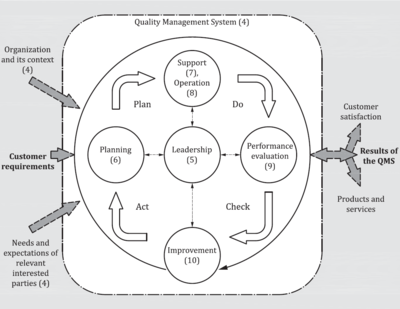ISO 9001
The ISO 9001 is a standard describing quality management system. It was first issued in 1987 and then updated each several years. The newest is the fifth version: ISO 9001:2015. The standard describes requirements that should be fulfilled in order to reach certificate of accordance with the standard. The certificate can be used by the organization to prove that it has working quality management system. This increases trust and can ease cooperation with other companies. If the enterprise has certified quality management system it should be able to fulfil its commitments - it's trustworthy.
The standard was issued by ISO - International Organization for Standardization, which publishes international standards. As a rule, all standards are voluntary, however enterprises implement them to ease cooperation.
The key to understand contemporary quality approach are quality management principles, which are a part of ISO 9001 standard since 2008 version. Earlier they were presented in ISO 9004:2000.
The ISO 9001 is a part of ISO 9000 standards family, which currently includes also ISO 9000 and ISO 9004. Other related standards are:
- ISO 10000 family - guidelines for specific methods,
- ISO 19011 - rules of audit,
- ISO 31000 - rules for risk management
- ISO 14001, 27001, 22001, OHSAS - other management systems compatible with ISO 9001
- ISO 17025.
History of ISO 9001 standards
- 1979: BSI issued BS 5750 quality assurance standard
- 1987: The first ISO 9001 standard describing quality assurance system based on BS 5750
- The ISO 9002 and 9003 standards were also published. They contained limited range of requirements. In case of ISO 9002 product development was removed, and ISO 9003 was limited to only final inspection and testing operations. The ISO 9004 standard describes guidelines of developing quality assurance systems. The ISO 9000 standard describes basics of quality approach.
- 1994: The second version of ISO 9001, which modifies some requirements that were ambiguous.
- 2000: The third version and major change. New title was introduced: Quality management system, which was a surprise to many people involved in quality movement. This issue includes process approach, different structure of requirements, less bureaucracy.
- The ISO 9002 and 9003 were removed. Instead, organization can remove some requirements of ISO 9001 which do not apply.
- 2008: The fourth version with minor changes.
- 2015: The fifth version introducing important changes: risk management supersedes preventive actions, improved quality objectives and planning requirements, improved resources related requirements, more flexibility, less bureaucracy.
ISO 9001 structure
ISO 9001:2015 introduced new structure of the standard:
- Scope
- Normative references
- Terms and definitions
- Context of the organization
- Understanding the organization and its context
- Understanding the needs and expectations of interested parties
- Determining the scope of the quality management system
- Quality management system and its processes
- Leadership
- Leadership and commitment
- Policy
- Organizational roles, responsibilities and authorities
- Planning
- Actions to address risks and opportunities
- Quality objectives and planning to achieve them
- Planning of changes
- Support
- Resources
- Competence
- Awareness
- Communication
- Documented information
- Operation
- Operational planning and control
- Requirements for products and services
- Design and development of products and services
- Control of externally provided processes, products and services
- Production and service provision
- Release of products and services
- Control of nonconforming outputs
- Performance evaluation
- Monitoring, measurement, analysis and evaluation
- Internal audit
- Management review
- Improvement
- General
- Nonconformity and corrective action
- Continual improvement
The third level of table of contents was omitted.
ISO 9001 certification
The ISO 9001 is a basis for certification. The ISO doesn't certify enterprises itself. Numerous certification bodies exist. They are accredited to certify quality management systems as compliant with ISO 9001 requirements. Usually the certificate is issued for three years, and each year the certification body provides an supervision audit. Other standards of ISO 9000 family are not certified.
The certification system has an important flaw. The certification body has a business interest in issuing certificates. If the organization fails during the audit, it can choose another certification body. Therefore, over years the certification bodies became to approach to the audit in more flexible way. This in long term decreases the value of ISO 9001 certificate. The certification bodies that keep high standards have less customers and therefore they can bye forced to leave the market.
Strengths and weaknesses of ISO 9001
| Strengths | Weaknesses |
|---|---|
|
|
Some publications claim that ISO 9001 can increase profits. It was true, however a research of literature studies on this subject in 2015 has proven that it is no longer true. The ISO 9001 is a "must have" in many businesses.
References
- Fonseca LM (2015) From quality gurus and TQM to ISO 9001:2015: a review of several quality paths, International Journal for Quality Research, 9:1
- Poksinska B (2006) ISO 9001 in smal organizations, International Journal of Quality & Reliability Management, 23:5
- International Organization for Standardization
- Risk management in ISO 9001:2015
- Planning in ISO 9001:2015
- Quality objectives in ISO 9001:2015
Author: Slawomir Wawak
